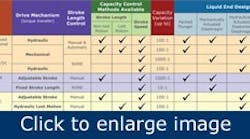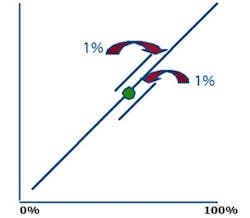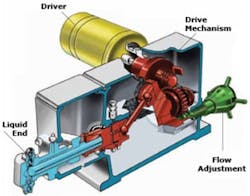Control the flow with metering pumps
In brief:
- Steady-state accuracy, repeatability and linearity are of great value in dosing pump applications.
- Accuracy is a critical element of controlled-volume metering pumps and is achieved through capacity control and pump head arrangements. Stepper motors eliminate the need for stroke length control.
- Controlled-volume metering pumps can achieve discharge pressures to 50,000 psig and capacities from 10 milliliters per hour to 5,000 gallons per hour.
HI is the largest association of pump producers and suppliers in North America and is a global authority on pumps and pumping systems. Its mission is to serve as a forum for the exchange of industry information, while providing value-added services to member companies and pump users worldwide. Nearly 100 companies belong to HI, and engineering consulting firms affiliate as “Standards Partners.” For more information about the Hydraulic Institute, its member companies and Standards Partners visit www.pumps.org, www.pumpsystemsmatter.org and www.pumplearning.org.
Along with e-learning courses, HI also offers ANSI/HI Web-based standards subscription packages. Web-based subscriptions provide company-wide access to the pump standards from anywhere in the world. Visit estore.pumps.org/subscriptions to learn more.
Attend any “Pumping System Optimization” course and receive seven PDH credit directly from HI. Those interested in hosting the course might do so at their own facilities. For more information about attending or hosting a course in 2011, visit www.pumpsystemsmatter.org or call Kathy Doran at (973) 267-9700, ext. 216.
One of the most widespread trends covered in the course, metering pumps, is the subject of the fifth module, a fact-filled, basic training. It takes a student from the very clear points of what distinguishes a pump as a controlled-volume metering pump to how the evolution of this branch of pumps is fulfilling the inventor’s vision that these pumps were always more akin to instruments than pumps.
During this e-learning course, participants will be introduced to the versions and forms of pumps that actually have sustainable, accurate capacity control inherent to the pumps themselves, thus distinguishable from pumps installed with motors that have speed control and from pumps in systems with control valves to divert or limit flow to the injection point.
This is the conclusion of a series of articles based on Hydraulic Institute’s comprehensive e-learning course, “Positive Displacement Pumps: Fundamentals, Design and Applications.”
During the past 75 years, there has been more technological advancement related to metering pumps than any other type. Almost all of this development has been more focused on producing a controlled limitation of flow than it has on improvements in flow inducement. As true controlled-volume metering pumps entered the 21st Century, this minor branch of the pump family tree will rely on a new platform for continued advances. Electronics and robotics have provided a significant improvement in the pump’s self-contained flow management resulting in automatic capacity correction that’s available and will be further enhanced in the future.
Robert Sheen invented the first pump that began this branch of the pump family tree. The core of his invention was a method of controlling volumetric flow that was actually part of the pump itself. It wasn’t dependent on a bypass valve after the discharge or pump speed changes by replacing belts and pulleys or even motors. It wasn’t dependent on changing pump size to limit the amount of chemical dosed to a specific application of boiler feed chemicals or cooling tower chemicals and not dependent upon the operator diluting the chemicals to match the application rate available from the pump. His invention was a means, inherent to the pump, to control the pump’s true output while maintaining consistent, repeatable volumetric flow accuracy over time. This reduced the amount of time spent on performance monitoring. It provided those involved with the chemical-feed industry a labor-saving device.
From this original controlled-volume pump, the terms “metering pump” and “dosing pump” have evolved as popular synonyms. It’s important to recognize that accuracy is a critical, value-added element of controlled-volume metering pumps. Different technologies are used for capacity control and different pump head arrangements have evolved to fill the broad spectrum of applications in which dosing pumps can be found globally.
Controlled-volume pumps are available in numerous versions and styles, having entered the market during the past seven decades. The configuration variety is primarily the result of the many industries with specific needs for sustainable accuracy in chemical dosing. Accuracy on three levels has become the primary benefit of this pump type in the delivery of additives to automated processes, as well as those with the simple mission of maintaining accurate constant flow. Metering pumps fill essentially this same set of process-critical needs in every industrial niche.
Controlled-volume metering pumps are used in a wide range of applications and environments. Process pressures can range from atmospheric pressure to 50,000 psig (3,500 Bar). Pump capacities per head vary from 10 ml/hr to 5,000 gal/hr. Several types of metering pumps have evolved to best suit each application to meet this range. Drives, control methods and liquid-end combinations have been designed to handle the full scope of applications (Figure 1).
Figure 1. This chart details the performance and mechanical characteristics of the standard array of metering pumps.
Even within the scope of applications best served by dosing or metering pumps, consider economics to select the best value proposition for a particular application.
Unlike most other pumps, cost of ownership or lifecycle cost usually isn’t heavily influenced by power consumption and repair costs. A more likely case often can be made for savings from high-level accuracy in the cost of chemicals metered or quality of a final product. These factors first drive the decision to the family of controlled-volume metering pumps and then to the appropriate model and version. Since the invention of controlled-volume pumps, the value of such technology can be found in the confidence that an operator has in the pump delivering liquid at the precise desired rate.
There’s often the attraction to the simple convenience of a compact package in a pump that has a built-in capacity adjustment. It’s still just as good of a reason to choose a controlled-volume pump as it was in the 1930s.
While metering pumps are an easy choice for the original invention’s intent, factors such as steady-state accuracy (Figure 2), repeatability and linearity represents even greater value in the majority of applications in which dosing pumps are found. Controlled-volume pump accuracy gives the confidence one can dispense the desired amount of liquid over extended periods of time. Many processes require pump discharge capacity to be varied by as much as 1000-to-1.
Figure 2. The plot of relative accuracy as a function of capacity setting shows that the metering pump can deliver predictable fluid rates.
While convenience of flow rate adjustment might cause an engineer to consider variable-capacity pump systems, the value of doing so diminishes quickly if the operator can’t depend on the pump to meter the same or planned variance of chemical at the predetermined settings repeatedly. The costs of compensating for variable-capacity pumps that have low accuracy rates can be extremely high in the form of extra components or in poor quality results from the process.
Controlled-volume pumps have never been greatly affected by the changes in the system conditions, and the newest metering pump technologies automatically adjust to keep the output accurate to maintain the set point, even when the discharge pressure changes. Nearly every recent innovation has made it easier for the operator to set metering pumps to the desired discharge rate with minimum or little effort. There’s no need to calculate the capacity change caused by stroke length change.
The first controlled-volume metering pumps had an electric motor with a belt and pulley drive. The commonly used drive types still include standard AC motors (Figure 3).
Figure 3. The earliest metering pumps were driven by electric motors.
Solenoid drive systems are probably the most popular today because of their competitive pricing. AC and DC variable speed motors are used in conjunction with stroke length control in some types. Pneumatic and hydraulic power sources are found in specialty applications like natural gas and agriculture. More recently, advanced electric motors, such as stepper motors, taken from the robotic and computer industry, have eliminated the need for stroke length control, simplifying setup and operation.
The capacity in the original metering pump was changed by adjusting the stroke length of the piston from outside the pump. Figure 4 shows the same concept, but its stroke length adjustment via an internal, oil-bathed gear system is a technology introduced about 30 years after the first metering pump. This drive type is readily available today.
Figure 4. Contemporary metering pump flow can be adjusted from outside the pump body.
The choice of drive system is important as it relates to durability, accuracy, automation levels, maintenance availability and cost. From the simplest timed triggering of a solenoid to electric motor versions as depicted above, all incorporate some capacity change. While speed initially was a secondary control method that extended the turndown ratios from the 2-to-1 or 3-to-1 limits to 10-to-1, speed was seen as a preferred capacity control in some applications. Speed brought accuracy problems.
Many controlled-volume pumps today incorporate both stroke length and stroke frequency/speed adjustments to provide as much as 100-to-1 capacity variation. Electronics, however, enable both wider speed variation and extreme accuracy to the point of eliminating the need to vary the stroke length and avoiding the hydraulic difficulties inherent to running pumps at less than full stroke length.
Matching of the correct liquid end to the correct drive mechanism is how this class of pumps delivers peace of mind to operators who need precise liquid delivery, from the original packed-plunger heads to diaphragm-liquid ends that incorporate sensors to monitor operation and accuracy.




